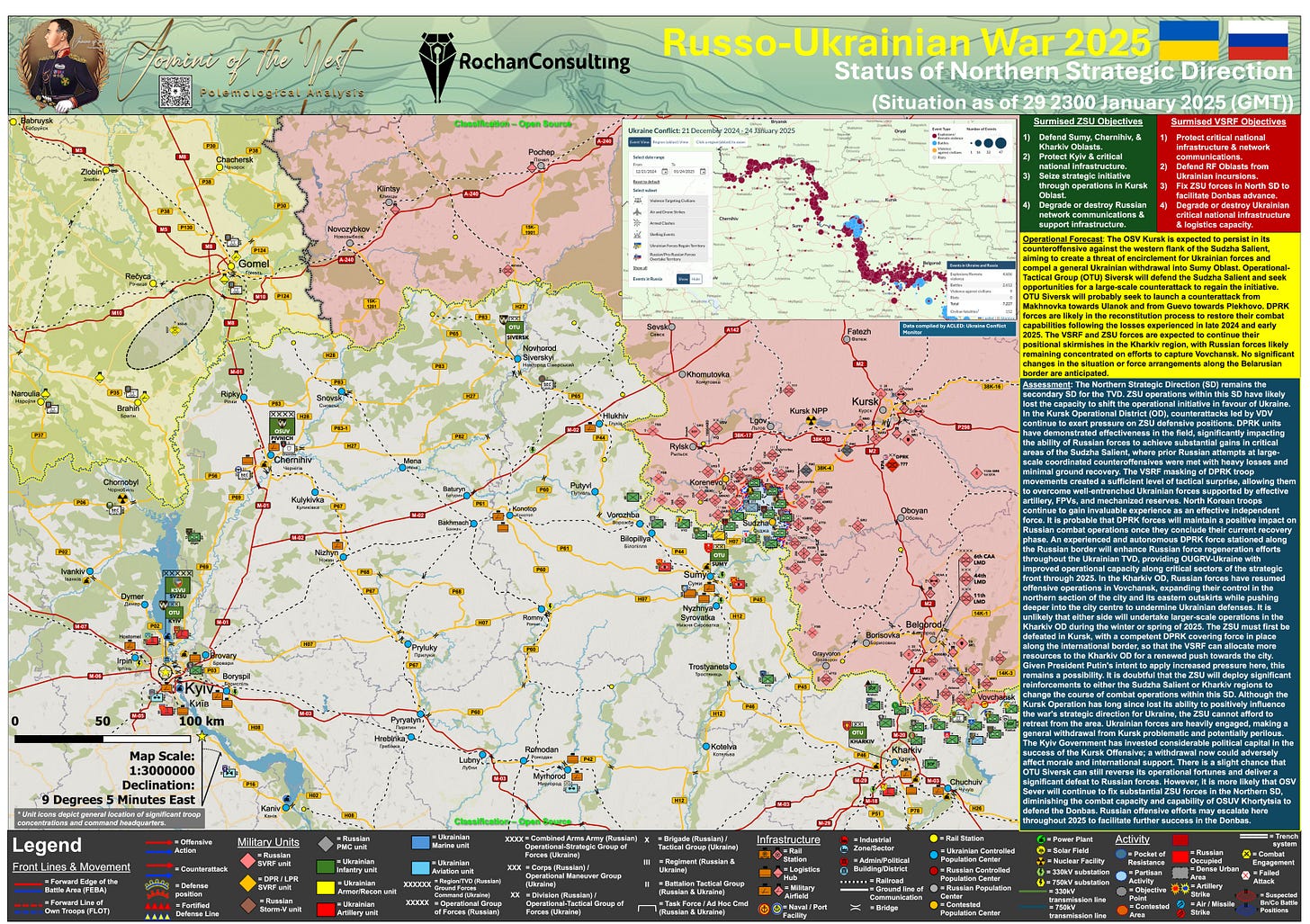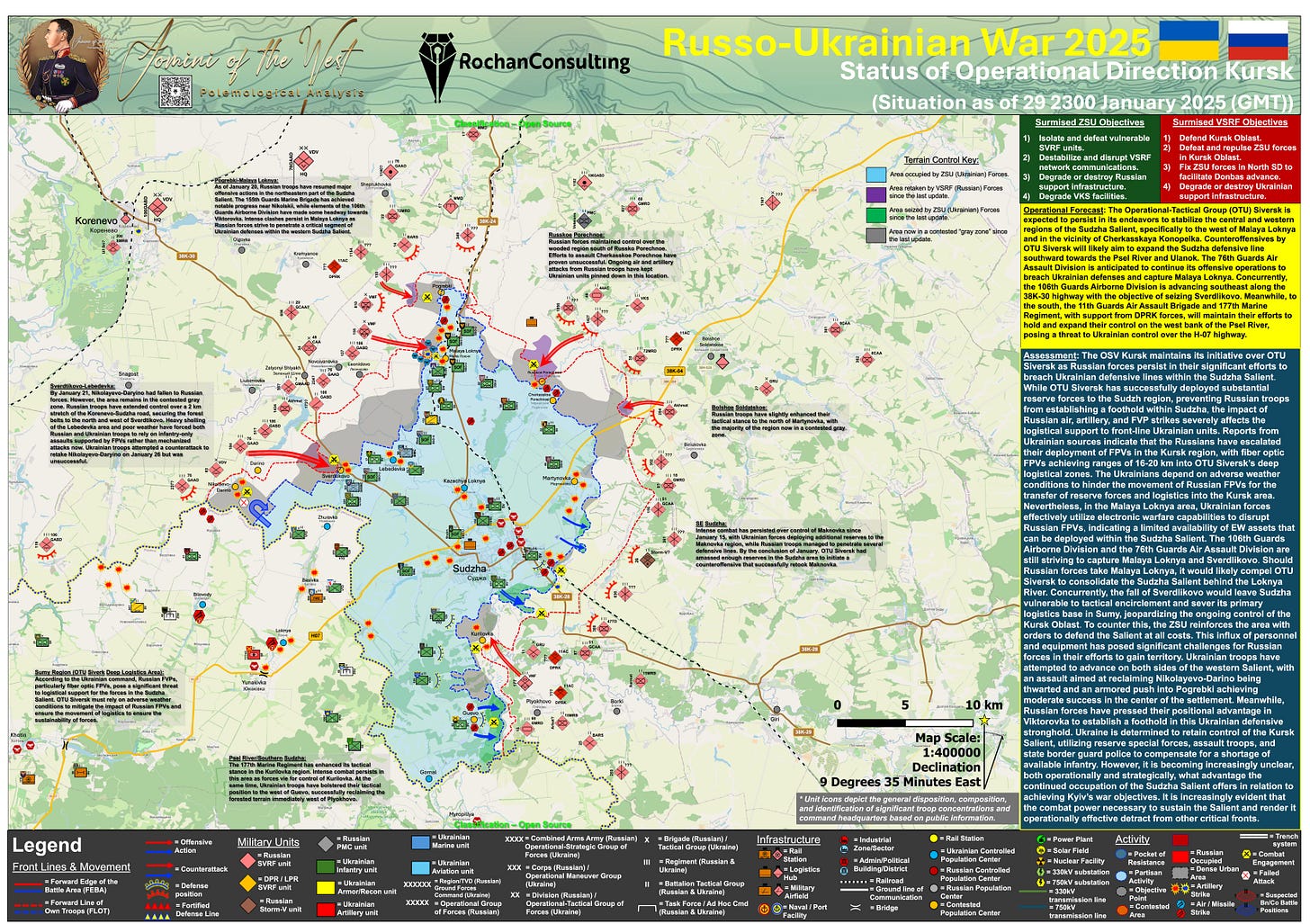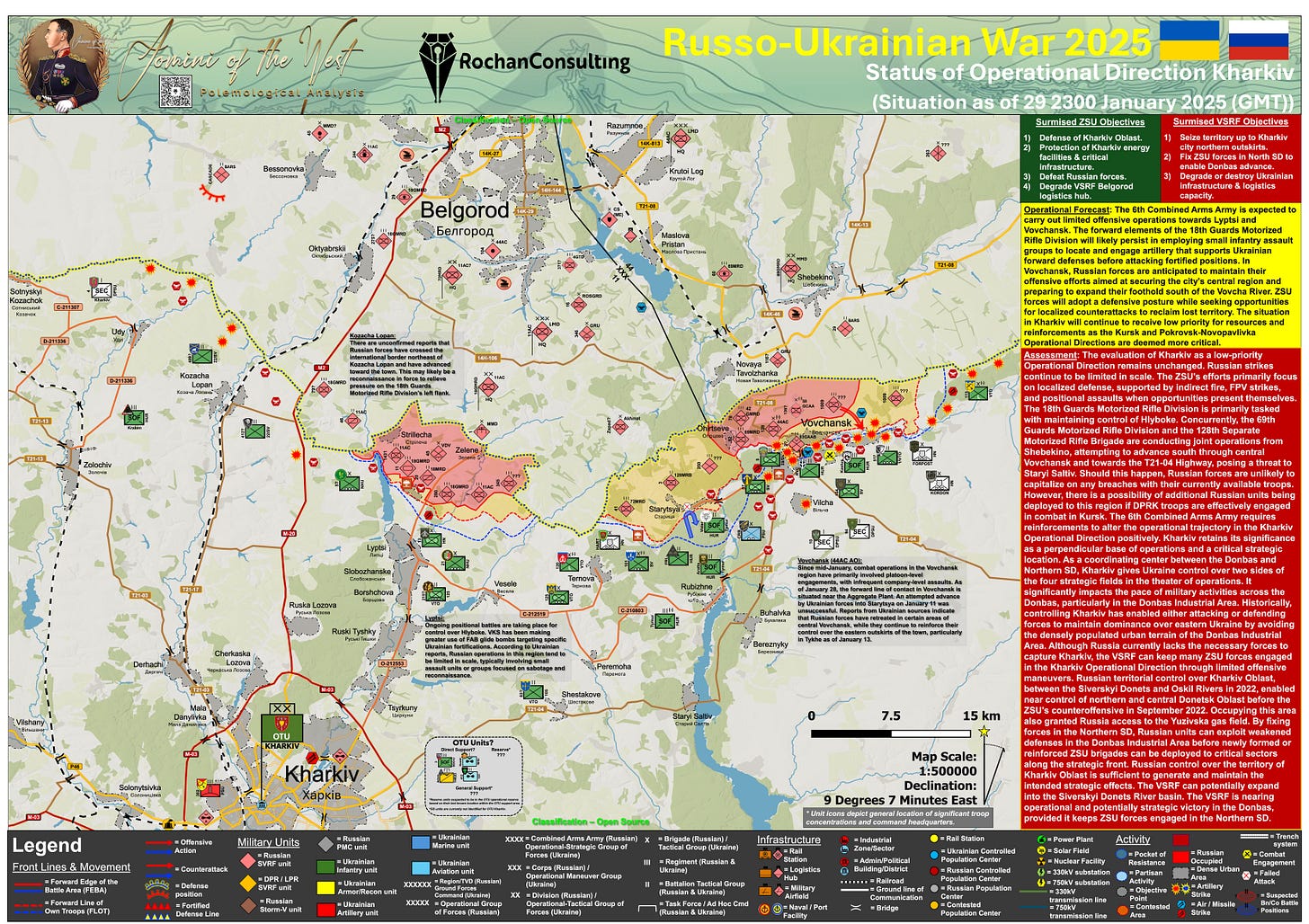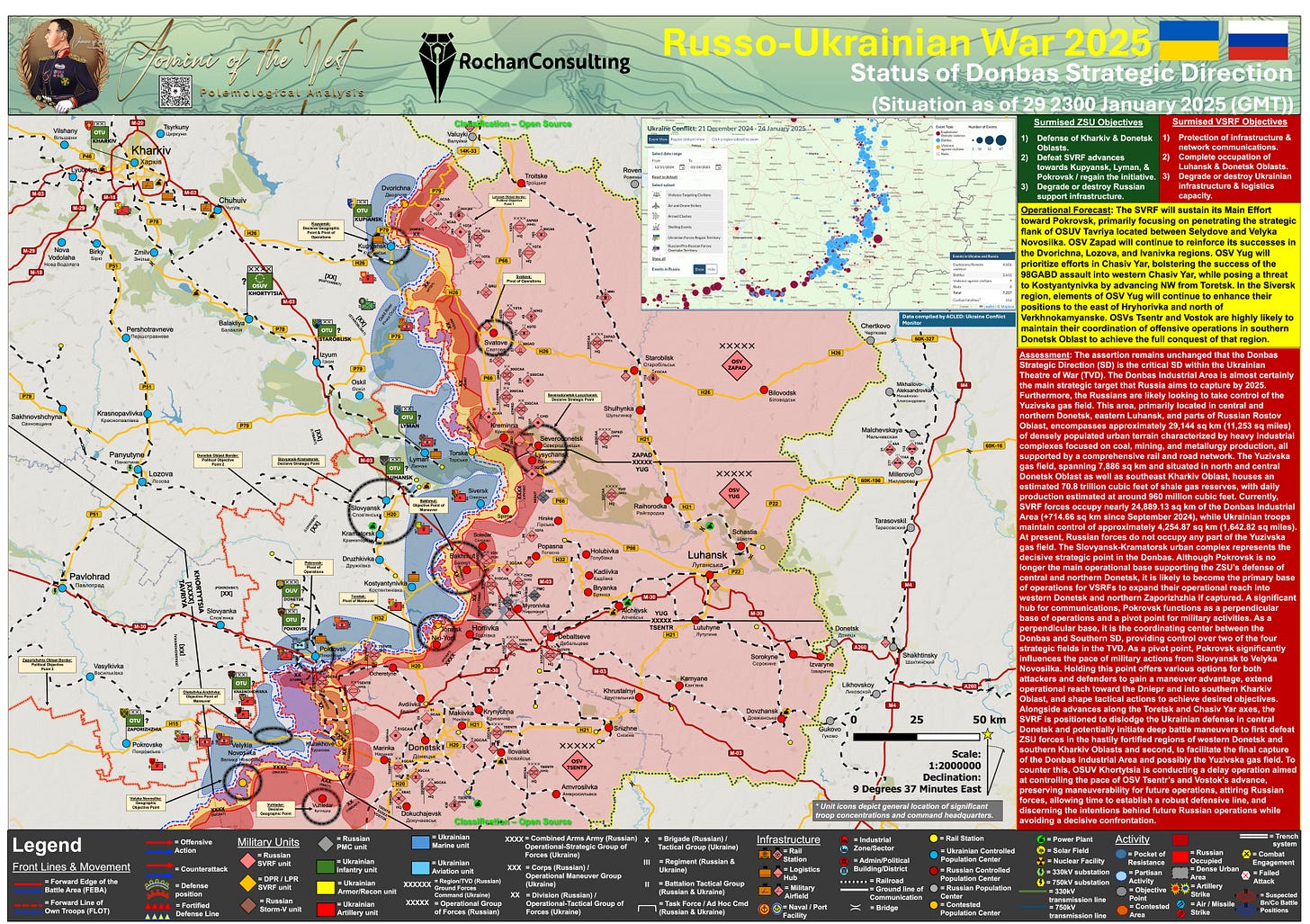Daily Tactical Update (DTU), Ukrainian TVD Day 1071
This DTU focuses on actions in the Northern Strategic Direction while highlighting events in the Donbas Strategic Direction.
Operational Overview: The Northern Strategic Direction (SD) remains the secondary SD for the TVD. ZSU operations within this SD have likely lost the capacity to shift the operational initiative in favor of Ukraine. In the Kursk Operational District (OD), counterattacks led by VDV continue to exert pressure on ZSU defensive positions. DPRK units have demonstrated effectiveness in the field, significantly impacting the ability of Russian forces to achieve substantial gains in critical areas of the Sudzha Salient, where prior Russian attempts at large-scale coordinated counteroffensives were met with heavy losses and minimal ground recovery. The assertion remains unchanged that the Donbas Strategic Direction (SD) is the critical SD within the Ukrainian Theatre of War (TVD). The Donbas Industrial Area is almost certainly the main strategic target that Russia aims to capture by 2025. Furthermore, the Russians are likely looking to take control of the Yuzivska gas field. This area, primarily located in central and northern Donetsk, eastern Luhansk, and parts of Russian Rostov Oblast, encompasses approximately 29,144 sq km (11,253 sq miles) of densely populated urban terrain characterized by heavy industrial complexes focused on coal, mining, and metallurgy production, all supported by a comprehensive rail and road network. The Yuzivska gas field, spanning 7,886 sq km and situated in north and central Donetsk Oblast as well as southeast Kharkiv Oblast, houses an estimated 70.8 trillion cubic feet of shale gas reserves, with daily production estimated at around 960 million cubic feet.
Kursk Operational Direction: The OSV Kursk maintains its initiative over OTU Siversk as Russian forces persist in their significant efforts to breach Ukrainian defensive lines within the Sudzha Salient. While OTU Siversk has successfully deployed substantial reserve forces to the Sudzh region, preventing Russian troops from establishing a foothold within Sudzha, the impact of Russian air, artillery, and FVP strikes severely affects the logistical support to front-line Ukrainian units. Reports from Ukrainian sources indicate that the Russians have escalated their deployment of FPVs in the Kursk region, with fiber optic FPVs achieving ranges of 16-20 km into OTU Siversk’s deep logistical zones. The Ukrainians depend on adverse weather conditions to hinder the movement of Russian FPVs for the transfer of reserve forces and logistics into the Kursk area.
Kharkiv Operational Direction: The evaluation of Kharkiv as a low-priority Operational Direction remains unchanged. Russian strikes continue to be limited in scale. The ZSU's efforts primarily focus on localized defense, supported by indirect fire, FPV strikes, and positional assaults when opportunities present themselves. The 18th Guards Motorized Rifle Division is primarily tasked with maintaining control of Hlyboke. Concurrently, the 69th Guards Motorized Rifle Division and the 128th Separate Motorized Rifle Brigade are conducting joint operations from Shebekino, attempting to advance south through central Vovchanskand towards the T21-04 Highway, posing a threat to Staryi Saltiv. Should this happen, Russian forces are unlikely to capitalize on any breaches with their currently available troops.
Donbas Strategic Direction: Currently, SVRF forces occupy nearly 24,889.13 sq km of the Donbas Industrial Area (+714.66 sq km since September 2024), while Ukrainian troops maintain control of approximately 4,254.87 sq km (1,642.82 sq miles). At present, Russian forces do not occupy any part of the Yuzivska gas field. The Slovyansk-Kramatorsk urban complex represents the decisive strategic point in the Donbas. Pokrovsk significantly influences the pace of military actions from Slovyansk to Velyka Novosilka. Holding this point offers various options for both attackers and defenders to gain a maneuver advantage, extend operational reach toward the Dniepr and into southern Kharkiv Oblast, and shape tactical actions to achieve desired objectives.
Donbas Operational Forecast: The SVRF will sustain its Main Effort toward Pokrovsk, primarily focusing on penetrating the strategic flank of OSUV Tavriya located between Selydoveand Velyka Novosilka. OSV Zapad will continue to reinforce its successes in the Dvorichna, Lozova, and Ivanivka regions. OSV Yug will prioritize efforts in Chasiv Yar, bolstering the success of the 98GABD assault into western Chasiv Yar, while posing a threat to Kostyantynivka by advancing NW from Toretsk. In the Siversk region, elements of OSV Yug will continue to enhance their positions to the east of Hryhorivka and north of Verkhnokamyanske. OSVs Tsentr and Vostok are highly likely to maintain their coordination of offensive operations in southern Donetsk Oblast to achieve the full conquest of that region.
Northern Operational Forecast: The OSV Kursk is expected to persist in its counteroffensive against the western flank of the Sudzha Salient, aiming to create a threat of encirclement for Ukrainian forces and compel a general Ukrainian withdrawal into Sumy Oblast. Operational-Tactical Group (OTU) Siversk will defend the Sudzha Salient and seek opportunities for a large-scale counterattack to regain the initiative. OTU Siversk will probably seek to launch a counterattack from Makhnovka towards Ulanok and from Guevo towards Plekhovo. DPRK forces are likely in the reconstitution process to restore their combat capabilities following the losses experienced in late 2024 and early 2025. The VSRF and ZSU forces are expected to continue their positional skirmishes in the Kharkiv region, with Russian forces likely remaining concentrated on efforts to capture Vovchansk. No significant changes in the situation or force arrangements along the Belarusian border are anticipated.
This open-source operational summary of the Northern OD is based on information from the ZSU and VSRF daily operations briefs, various Ukrainian and Russian Telegram channels, Western intelligence agencies' public statements, military analysts, and my own professional experience. Any errors in the information and translation presented here are strictly my own, and they will be corrected in the following update.








